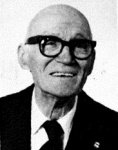SABR Salute: Alex Haas
Editor’s note: The SABR Salute, first bestowed upon writer Fred Lieb in 1976, was designed as a manner of recognizing the contributions of some of the older members of the Society. Subsequent SABR Salutes appeared in the SABR Membership Directory and honored members who had made great contributions to baseball historical research. Alex Haas received the SABR Salute in 1980; the following biographical sketch appeared in that year’s membership directory.
 Alex J. Haas of Berkeley, Calif., is one of those baseball researchers who has labored for years in virtual obscurity but who nevertheless has made a substantial contribution to the historical and statistical knowledge of the sport. This contribution is measured in part by the 13,000 pages of research information he recently turned over to the Hall of Fame in Cooperstown, N.Y.
Alex J. Haas of Berkeley, Calif., is one of those baseball researchers who has labored for years in virtual obscurity but who nevertheless has made a substantial contribution to the historical and statistical knowledge of the sport. This contribution is measured in part by the 13,000 pages of research information he recently turned over to the Hall of Fame in Cooperstown, N.Y.
The Society has only about a half-dozen members who were born in the 19th century. Alex is one of those, but just barely, having been born in Holton, Kan., on Dec. 20, 1899. He dates his interest in baseball from the 1913 World Series, at which time he “adopted” Christy Mathewson as his favorite player based largely on Matty’s shutout victory over the A’s in that fall classic. He purchased his first copy of The Sporting News while in high school in 1914, and he hasn’t missed many since.
Alex was a sociology major at Baker University in Baldwin City, Kan., receiving a B.A. degree in 1925. He went on to graduate school at Boston University and it was in that city where he saw his first major league games. His biggest baseball thrill came on April 26, 1927 when he saw 40-year-old Ty Cobb lead the A’s to a 9-8 victory over the Red Sox at Fenway. Cobb hit a double and two singles, stole home and ended the game dramatically by making a spectacular shoestring catch in shallow right field and then dashing to first base to complete an unassisted double play.
Alex operated the home farm near Topeka, Kan., from 1931 to 1942 when he went on active duty with the Army in World War II. He served until 1943 when he was discharged at age 43 at Camp Roberts in California. He shortly took a job as a clerk with the Southern Pacific Railroad and was assigned to Oakland, where he worked until his retirement in January 1971.
Back in the late 1930s, Alex had started compiling baseball statistics from the newspaper files of the Kansas State Historical Society in Topeka. He resumed this activity in a systematic way toward the end of WWII in the San Francisco area. By 1952 he had established a reputation in the Bay Area for baseball knowledge. This is confirmed by a lengthy Sunday feature on Alex in the San Francisco Chronicle on January 27 of that year. He used his vacation time and his railroad pass for extensive travels to major league cities, where he usually went to the libraries rather than the ball parks. He also did extensive work at Cooperstown, the Library of Congress in Washington, and at the American and National League Offices, then located in Boston and Cincinnati.
Alex concentrated much of his research efforts in the period 1900 to 1925 when the official records were not as complete or as accurate as later. He supplemented the official records by compiling on his own, for example, the hit-by-pitch records for batters from 1909 to 1920. He has reconciled record inconsistencies in the career marks of many of the players in the Hall of Fame and has compiled minor league debut dates for many of these stars. He is very careful in procedure, researching all the available sources before coming to any conclusion.
From 1971 to 1976 he researched five days a week like a regular job. As a result of that effort, he began to turn over his carefully transcribed notes to the Hall of Fame.
Through all this scholarly activity, Alex has had the patient indulgence of his wife Hettie Mae, whom he met in college in Kansas. Of course, Hettie Mae had her own career to pursue-as a Methodist minister. Alex himself reflects a deep religious conviction, as well as a very modest, quiet demeanor. Although he has been a member of SABR since 1971, he is not as well known in the Society as he should be. Possibly this SABR Salute will help correct that situation.
To get back to the SABR Salute page, click here.

